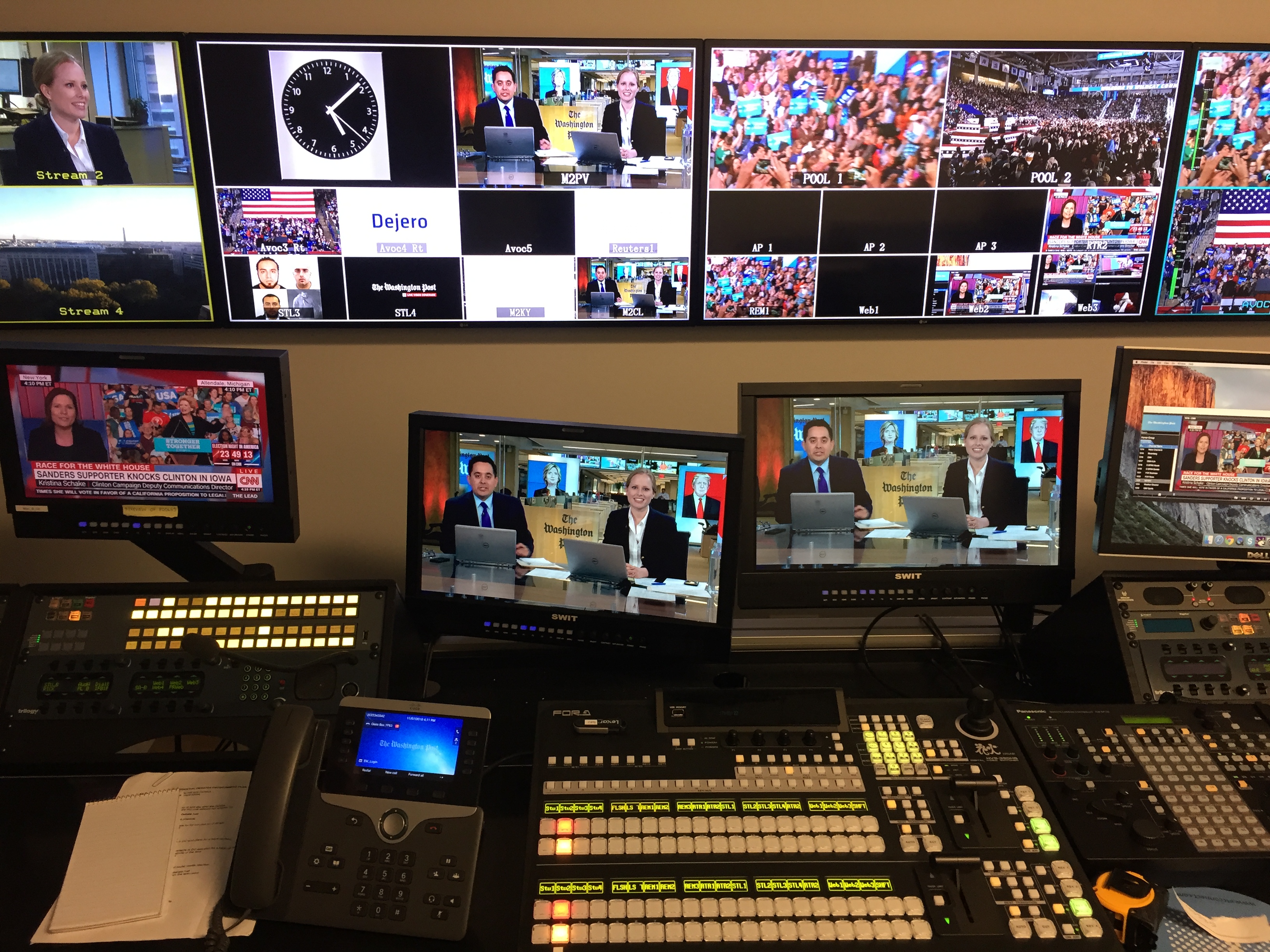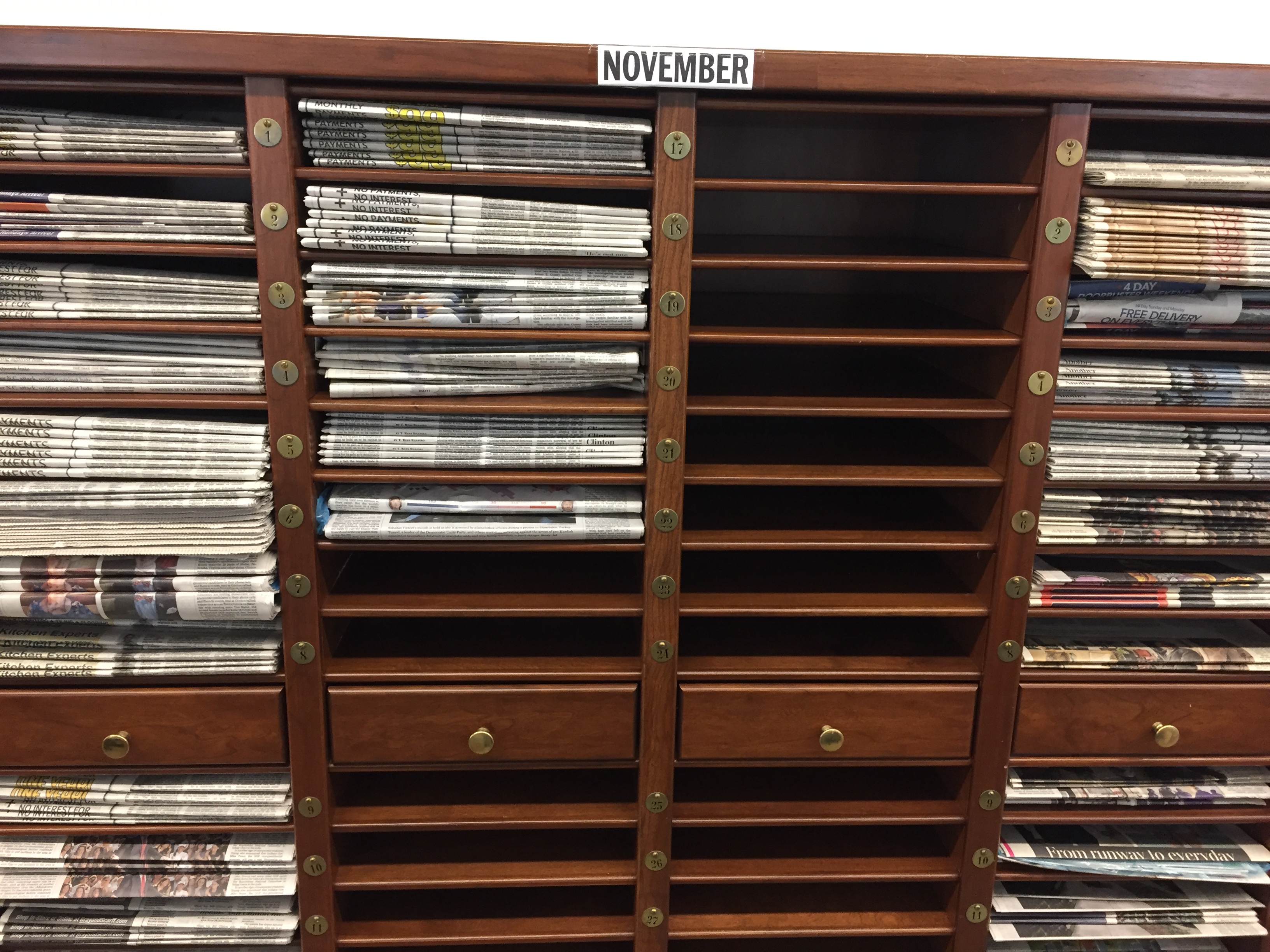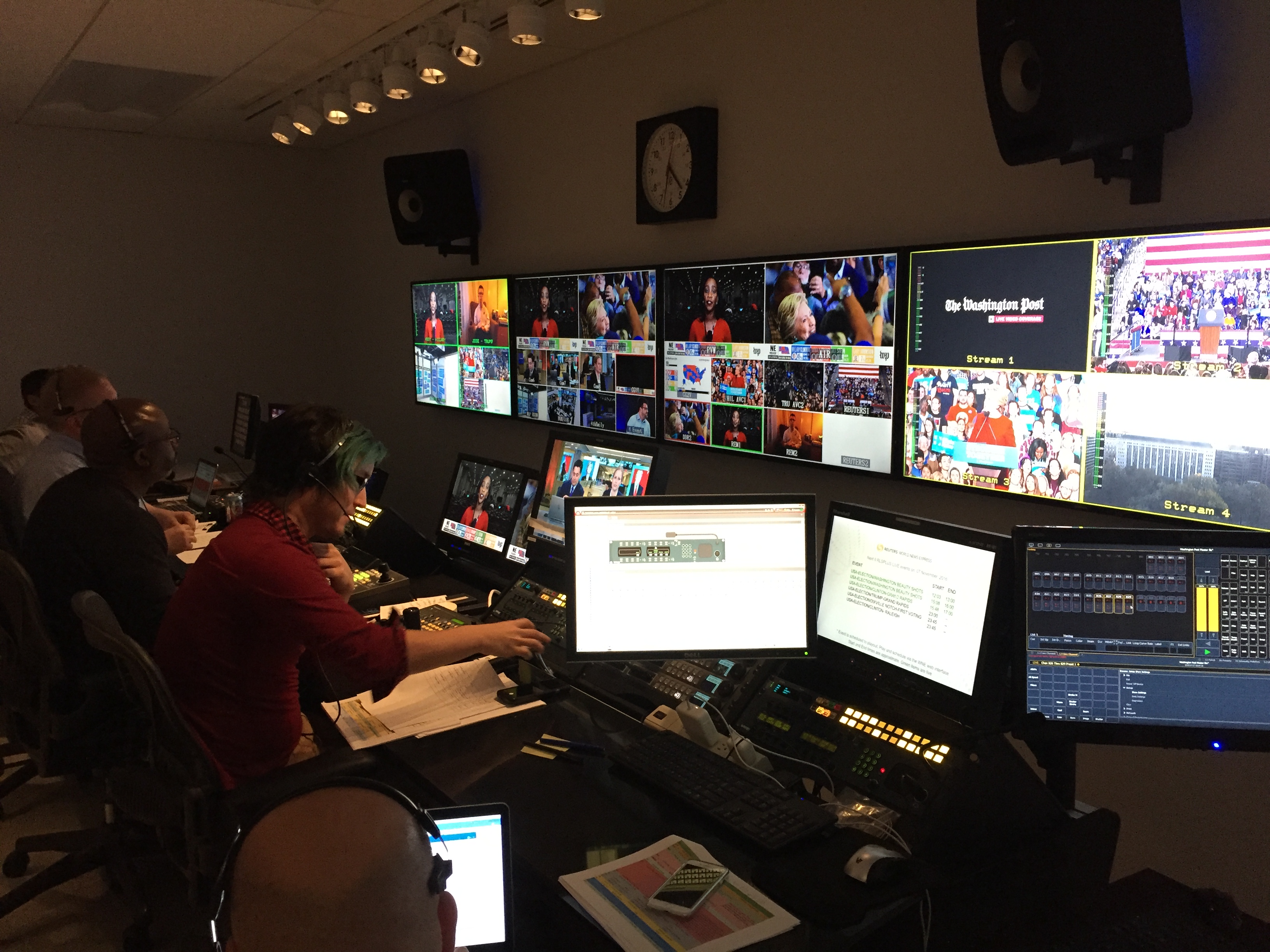WASHINGTON, D.C. — Ed O’Keefe and Elise Viebeck sat in a chilly TV studio on the 7th floor of The Washington Post. Through the glass wall behind the two reporters, people moved through the newsroom’s hub. On the wall behind them, graphics of Hillary Clinton and Donald Trump stared straight ahead.
O’Keefe and Viebeck looked at their computers and shifted in their chairs, waiting for their introduction.
It came, after several minutes, from the candidates themselves. Quotes from Trump and Clinton filtered into the studio. And then it began.
“Who gets to live at 1600 Pennsylvania Avenue for the next four years?” O’Keefe asked, looking into the camera. “Tonight, we find out.”
This, actually, was Monday afternoon at the Post.
Tonight we really do find out.
On Monday, the Post ran through a dress rehearsal leading up to its live election night broadcast. Around the newsroom, other departments had dress rehearsals of their own: Some spent months testing storytelling on different platforms, and others figured out how to blend copy from reporters with stories generated by automation technology.
Poynter spent Monday at The Washington Post to see how the newspaper — which has transformed into a national digital news organization in recent years — prepared for the conclusion of a historic campaign.
Here’s what we found.

Election night eve at The Washington Post. (Photo by Kristen Hare/Poynter)
“One day to go, make it count’
This morning, Senior Politics Editor Steven Ginsberg planned to get up and vote for his brother.
“I think he’d be great,” Ginsberg said, “but I don’t think there’s a groundswell.”
Former Post editor Leonard Downie Jr. famously didn’t vote at all, and Ginsberg, who has been at the Post for 22 years, didn’t used to understand why. But he’s come to realize that holding his position and choosing among the candidates he’s covered isn’t easy.
So, as he has for a few presidential elections, Ginsberg will vote for his brother. Then, he plans on one long day.
The big story will be what’s happening at the polls. Thanks to the Post’s Talent Network (think TaskRabbit for freelancers), reporters around the country are ready to go if news happens in their area. Ginsberg has people available in every state.
“That enables me to use my political team in a different way,” he said.
A few reporters are with the candidates and will be filing stories and reporting on Facebook Live. Others are in spots around the country where Ginsberg expects news, including North Carolina.
They’ve thought through a few different scenarios. A reporter is ready in Mississippi if Clinton wins to offer a window onto her victory from a state that trails the nation in electing women. Another reporter will attend White nationalist David Duke’s election night party for a story about the alt-right movement.
“You have to be prepared for every eventuality,” Ginsberg said.
That’s why the Post’s David Fahrenthold spent Monday pre-writing a few dozen stories with different scenarios: If results come in but they’re contested; if there’s a lawsuit; a landslide; a candidate won’t concede.
Ginsberg’s planning today’s coverage in addition to stories for late tonight and early Wednesday morning. Unlike past elections, he expects peak traffic will come during those times. The first shift will offer the news itself, the second will add a layer of analysis.
“You have to basically organize your staff for that shift, which is not a shift,” he said, “it’s basically an endurance test.”
On the glass wall of his office that morning, he scribbled something in black dry erase marker. It was the final day of a countdown he started months before: “One day to go. Make it count.”

Recent newsroom archives at The Washington Post. (Photo by Kristen Hare/Poynter)
I, Heliograf
This election also marks a major milestone for The Washington Post: For the first time in its history, the newspaper is covering Election Day with the help of automation technology. The Post first started using the technology, called Heliograf, to cover the Olympics. Today, it will use Heliograf to report results from 500 races.
Those stories, which use data from the AP and analysis from reporters, will be updated as results come in and offer readers a changing look at the balance of power.
“What I think is particularly exciting about this is we built a system that lets us take that data, then come into the story and combine with analysis from reporters,” said Terri Rupar, national digital editor.
Those stories use expertise from reporters familiar with House and Senate races, and they read like Post articles — not just summaries of data. Those stories will be geotargeted to find readers where they are, giving them results in the races they voted for, said Jeremy Gilbert, director of strategic initiatives. The Post’s newsletters will also update automatically, offering new results as people open them again.
It all reflects the Post’s status as an increasingly national publication, he said. Its ambitions are far larger than they were four, or even two years ago.
“This cycle, there’s really been no limits to what people are willing to try or talk about or figure out what we can do,” Rupar said.
This year’s big experiments didn’t come because owner Jeff Bezos came in and bought new ideas, Gilbert said. When the Amazon founder bought the newspaper in 2013, he enabled the staff to accomplish things they couldn’t before.

The Post will use high and low tech to show electoral college results tonight. (Photo by Kristen Hare/Poynter)
And now, live from…everywhere…
“Tomorrow’s already started,” Micah Gelman, director of video, said on Monday.
Election Day is mostly waiting followed by a rush of news, he said. So, to prepare, The Post has been planning and practicing for a live broadcast from headquarters.
Beginning at 7 p.m., the Post’s broadcast will air online and on Facebook live. They’ll move from O’Keefe and Viebeck in the newsroom to the Post’s Chris Cillizza, who will offer deep dives with interactive maps. Then, the broadcast will go to the newsroom’s hub and reporters at both campaigns’ election night watch parties.
Post reporters often appear on cable news, and they will again tonight, but the Post wanted to offer their reporting and reporters directly. Gelman knows there’s a lot of competition on Facebook Live, and he’s hoping the quality of the Post’s will stand out.
Elections have always driven new technology for news organizations in a way that no other event can, he said, from the early days of newsroom computers on. This is no different.
“If you’re not gonna go all out for this,” Gelman said, “what are you gonna go all out for?”

The 8th floor control room at The Washington Post on Election Day eve. (Photo by Kristen Hare/Poynter)
Four years ago, Director of Audience Growth Ryan Kellett was covering the election on the politics team. This year, as director of audience and growth, he feels a lot less anxious. But that’s not because his role his different.
“I feel like we’re more prepared and more thoughtful about our coverage,” Kellett said.
The difference now, he said, is more planning and a deeper understanding of what they’ll share on different platforms, what those audiences expect and what his team should prepare for.
That’s something the Post’s editor, Marty Baron, pushes them all on, Kellett said. Now, it’s baked into a lot of newsroom routines.
For the first time this year, they’re creating content on a large scale for specific platforms rather than repurposing other work. That’s something they’ve been building to for awhile. On Snapchat, they’ll have both campaign parties. On Instagram, they’ll have election how-tos during the day, then results and maps at night.
They’ll be on Twitter with updates, on Viber with the Post’s international audience and on Facebook Messenger with their “Feels Bot.” They’re taking their “No Stupid Questions” project, which started on Tumblr, across platforms.
Kellett’s team works where the Post meets its readers on social platforms, and they’ve found that “there’s just a lot of basic things that readers want to know in those spaces.”
With “No Stupid Questions,” they’ve tried to find things readers want to know and harness the expertise of Post reporters.
“Increasingly,” he said, “I think we’re also really finding ways to meet our readers in a place where maybe they’re not insiders.”

Each side of The Washington Post’s Instagram landing page have standout moments from the two candidates. The center has moments when they’ve come together. (Screen shot)
Election 2020
Four years ago, Joey Marburger’s job didn’t exist at The Washington Post.
Now, as director of product, he oversees an intersection of product and design. And today, his job should be pretty easy. Most of his team’s work was preparing for huge traffic, perfecting alerts and fine-tuning tools the Post uses to publish onto Apple News and Facebook Instant Articles.
Compared with two years ago, he said, the Post has many more tools and a much bigger audience. His job is to pursue experiments and make the Post’s core efforts stronger. It’s not all about glitzy new products.
“I think those days have kind of gone away,” he said. “It’s more, let’s find new distribution channels, also who exactly are we looking for in those distribution channels?”
The Post focused all its efforts on its homepage four years ago. And that still matters. But now, Marburger said, the homepage mentality has moved to other products. They’re focusing on the automated newsletters, the work of Heliograf, experimenting with 3D printing and integrating teams of designers, developers and reporters that have come closer together since the Post moved into its new building.
They’re ready, he said, because everything leading up to this has been practice.
“Maybe it’s a cheesy thing to say, but it feels like this election is like almost a cherry on top of all the growth we’ve had,” he said.
While a lot of people at the Post will be looking ahead to Wednesday and the next 100 days, Marburger’s already thinking about 2020, he said. Websites won’t be the same by then. Distribution won’t be the same. The experience of consuming news will be new. How can the Post be ready for it?
“Our focus at the Post has always been asking different questions, doing the stories that no one’s doing,” he said. “Journalism is our No. 1 product in a lot of ways. For me, what are the products we’re not building? What are the technologies we’re not looking at? What can we do to experiment there and show it’s safe to do?”
A 52-inch screen in his office holds one experiment they’re already considering. It’s a smart mirror they built, with headlines, weather and more on each side.
Like his job four years ago, it doesn’t fully exist yet. But if it becomes important, they’ll be ready.

The view into The Washington Post’s 7th floor newsroom the day before the election. (Photo by Kristen Hare/Poynter)
Lights, cameras, waiting
The quiet in The Washington Post’s newsroom began to shake loose late Monday afternoon.
While Viebeck and O’Keefe moved through their rehearsal on the 7th floor, a video engineer dangled a jib with a camera over the hub from the eighth floor, testing the view they’ll be offering of the newsroom at work during the broadcast.
Down the hall, a control room full of people watched as national political reporter Abby Phillip practiced from the hotel where Clinton will hold her election night party. Then, they threw it over to national political reporter Jose DelReal from the hotel where Trump will hold his party. DelReal, who couldn’t get into the election night space for a test run, comes in live from a chair in his hotel room.
The control room broke into laughter for a minute as he continued in yellow lamp light.
Then, everyone got back to work.
It’s been a long election. This could be a very long day.
Whatever happens tonight, they plan to be ready.







